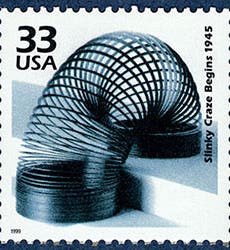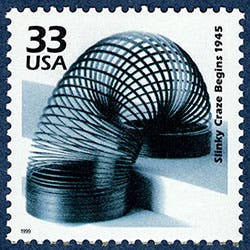Scientist of the Day - Betty James
Betty James, a businesswoman and manufacturer, died Nov. 20, 2008, at the age of ninety. Ms James was the matriarch of one of the great mechanical toys of the 20th century, the Slinky. How she did this, in the face of the obstacles of life and a derelict husband, is an inspiring story.
The Slinky was invented – conceived is perhaps a better word – by Betty’s husband, Richard, who worked for a plant in Philadelphia that manufactured parts for aircraft. As the story goes, and it sounds likely, one day in 1943, a coiled steel spring fell or was knocked off a shelf and proceeded to do handsprings all the way down to the floor. Richard went home and told Betty that such a spring might make a good toy. They managed to manufacture 400 of them at a small workshop in Clinton Heights just west of Philadelphia – Richard must have been a pretty good machinist, even if he was a flop as a husband – and they convinced Gimbel’s to let them demonstrate and sell their product during the Christmas season of 1945. Betty remembered that they sold all 400 Slinkys in about 90 minutes, and the boom was on. Popular Science ran a one-page story on the sensational new toy in 1946 (third image)
The business did well for about a decade, and then sales fell off. Richard decided that he wanted out, and the two were divorced, with Richard running off to Bolivia in 1960 to translate Bibles for the Wycliffe Society, leaving Betty with six children to feed and a failing business as her only source of income. But she hammered the business back into shape and made it work. She commissioned a jingle in the early 1960s and had it played over and over on television until everyone was humming it. She moved the factory to Hollidaysburg in south-central Pennsylvania, where it continued to operate up until she sold the company in 1998, and then until her death in 2008. Up to that point, every single one of the estimated 300 million Slinkys in the world was made in that plant on the original machinery. A Slinky dog was introduced in the 1970s, and when a scrubbed-up version of the toy appeared in Toy Story in 1995, sales received a further welcome boost.
One thing that Betty insisted on was keeping the price down, so less fortunate families could afford it. The original Slinky sold for $1.00, and that price held firm for a long time. Even now it is relatively cheap, although likely to be made of plastic these days. I own a fairly early Slinky – not from the 1940s, but probably from the 1960s (fourth image). It continues to work well, and I have never had to change the batteries. I could use it to teach a little physics, I suppose, but I don’t. I just use it to delight my grandchildren – a Slinky is very good at that.

An early Slinky (1960s?) with its original box and instructions (author’s collection)
In 1999, the U.S. Postal Service, in their ever-persistent efforts to sell you stamps that you will collect and won’t use for postage, issued a series of 10 sheets of 15 stamps each, one sheet for each decade of the 20th century. The sheet for the 40s decade had only one toy among its 15 stamps, and that was the Slinky, with the caption: “Slinky Craze Begins 1945” (first image).
In 1999, the National Toy Hall of Fame inducted its initial class of honorees. Included were Barbie, the Erector set, Etch-a-sketch, the Frisbee, Monopoly, the Duncan yo-yo, and 10 others, but no Slinky. Our little bundle of energy had to wait until the next year, 2000, to be honored, along with that other ignored classic, Mr. Potato Head. Fortunately, Betty James was alive to see that initial snub corrected. She herself was inducted into the Toy Manufacturers Hall of Fame in 2001.
There are many Slinky videos on YouTube. This one is more historical than most, and gives us a brief look at Betty James herself. She must have been a remarkable woman.
William B. Ashworth, Jr., Consultant for the History of Science, Linda Hall Library and Associate Professor emeritus, Department of History, University of Missouri-Kansas City. Comments or corrections are welcome; please direct to ashworthw@umkc.edu.










